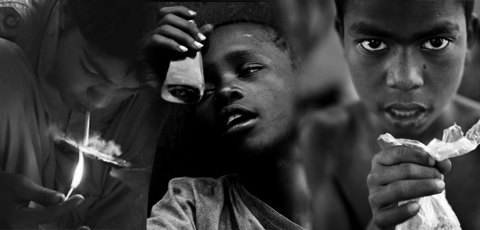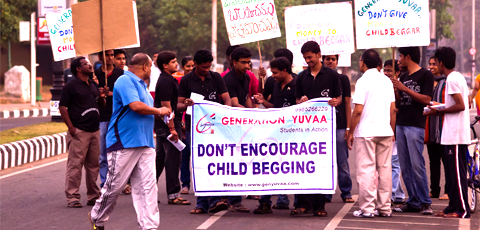Eradication of Child Begging

Our Work for Eradication of Child Begging
- Types of child begging
- Factors responsible for child begging
- Effects of Child Begging
- Statistics of Child Begging in Visakhapatnam
- Policies and legislation on Child Begging and its Violation
Many children are getting habituated for easy money, by using begging as a means of getting that money. People in general give these children money feeling sympathetic towards them. The amazing fact is that many beggars are professional beggars and many of them are involved with criminals. In many big cities in India beggars are much organized and do their work with lot of planning.
Begging prevents children from realizing their full potential restricting them to begging. Unfortunately, these children have a very tough time breaking out of their helpless situation.
Since begging is still considered a shame, beggars move to places and states where their original family identity cannot be easily recognized by people from whom they seek alms. Some beggars are professional beggars in the sense that begging becomes a chosen profession for them. The earnings they make through begging are carefully saved and sent home to support the other family members. However, the number of people who beg out of indigent circumstances still appears to be very large in India.
Types of Child Begging:

There are certain patterns that are observed in Child Begging.
The children directly beg the money from the public while sometimes the child is used as a medium for doing the same. Each pattern is briefly explained below.
In Mother Child begging, the child is used as a medium for begging. Usually the mother is seen carrying the child who is either conscious or unconscious. Children are made unconscious by giving them some unconscious causing drugs and then beg from the people for their recovery and taking them to hospital.
The other side of this story is that often these children are not their own, they were either purchased from poor families or kidnapped from different places of India. Many of these children die or lose their mental balance due to this regular poisoning.
Another pattern that is noticed is where the child is begging directly by amusing people with the help of an animal like a monkey or performing certain tricky acts like walking on a rope etc., Another common pattern is where the child paints himself like Gandhi and asking for money.
Being physically handicapped and using this to beg is also something that is seen very common while begging. Most of the times, it is seen that the child is pretending to be handicapped and is not actually so. Sometimes children are forced to lose their limbs so that they can be a medium for begging throughout their life. These kind of atrocities are also done by certain gangs that operate begging about which we will be discussing later in the report.
Religion is also used as a medium for begging in children where the child is either in attire that represents certain religion or the child is seen carrying photos of Gods while begging.
Factors responsible for child begging:

There are varied factors that influence these children to choose begging as a means of earning money. Some of them are discussed below.
One of the major reasons that are seen is that the family is from below the poverty line and usually the parents are the one who choose begging for their children. The money that is earned by the child by begging is used to support the family financially.
One of the other reasons is that the child is an orphan and is directed towards begging by the other children or the families that are already into begging.
Sometimes the child may have conflict with his/ parents and may run away from home and thus is again directed into begging.
Many a times it is seen that the child is unable to handle academic pressure from the parents and runs away from his family to avoid it.
It is also seen that begging is operated as an organized crime by a gang. They buy or rent children to use them for begging and thus the children get involved in the vicious circle. And often it is impossible for them to break out of it.
Effects of Child Begging:

The entire childs holistic development is majorly disrupted in this issue. Some factors are discussed below.
The childs health and mental health is affected negatively. Different domains of the child's development like behavior, education, psychological development and various other domains are affected.
There is also a high possibility that the child is exposed to issue that are not appropriate for his/her age. For example getting into drugs leading them into drug addicts or early exposure to sex are huge risks for the child well-being.
Children who are involved in this cycle will automatically guide their next generation into same situation of begging.
These children are often seen adapting to anti- social behavior leading them to involve in issues like thefts, crime and other malpractices.
These kind circumstances affect the society and country on a larger picture. It is disheartening to see the children who will be youth one day that the country should be proud of are limiting themselves to begging and negatively affecting the society.
Statistics of Child Begging in Visakhapatnam:
In Visakhaptanam district if we consider the area from Aanakapalli to Tagarapuvalasa, there are approximately 450 to 500 Child Beggars. The ratio of Girl beggars to the Boy beggars is 1:1 which means that there are equal number of girls and boys who are into begging. Certain areas where the Child Beggars are seen that most are railway station, RTC complex, Beach, NAD junction, Satyam junction, CMR central junction, Gopalapatnam, Gajuwaka junction, Srinagar colony, Anadapuram, Pendurti junction and Simhachalam.
Usually it is seen that the families who are involved in begging in some of these areas are the migrated ones. These migrated families don't stay in one place and are seen travelling from one area to another. So tracing them and keeping a trace of them is often a challenge.
Policies and legislation on Child Begging and its Violation:
Children Care and Protection Act, Sec (a) and Sec (b) of Juvenile Justice Care & Protection Act, 2000 (Amended 2006) which was earlier called as Juvenile Act, is the act that exists for these children. Children below 18 years, both girls and boys come under this act. Earlier the age limit was15 years for girls and 18 years for boys but now it has been made as 18 years for both the genders. The Act states that the children who are involved in begging are counted as neglected children and the children can be moved to rehabilitation centers for their positive development. Parents who are identified as a part of this and if we have an identified testimony will have to be counseled and explained about the well-being of the child. Our project is designed as per these guidelines.
Our Work

Generation Yuvaa Child Home (HOME FOR NEEDY)
Generation Yuvaa has started a Child Home to provide a shelter for street children, orphans and street beggars. The strength right now is 173 children who came from lower socio economic strata. These children are provided with basic facilities like shelter, clothing and food along with education. Some of these children who are old enough to go to school are funded for their education. Along with this, the childs overall development is also focused by indulging them in various physical activities and play. Certain standards are followed while preparing food keeping the nutrition norms in mind. Along with this, weekly health checkups are done by medical professionals.

Interventions by GENERATION YUVAA:
Spreading awareness: Gen Yuvaa focuses on spreading a lot of awareness about child begging to bring the focus on the issue that it is a major social issue that needs to be worked on. This is done using various ways like spreading pamphlets, rallies and other resources.
Child and parental counseling: Appropriate counseling sessions are given to the child who is recused either from child begging or otherwise. At times when families are involved, parents are counseled as well. The organization follows ethical counseling which means that the child or the parent is never pressured to be a part of the session and the confidentiality of the cases are not disclosed without permission.
Child rehabilitation: Once the family and the child are counseled, the child enters the process of rehabilitation. By assessing the age and the interest expressed by the child, he/she is either sent to school or is trained vocationally to provide employment. In certain cases, where the child is interested in education but is not financially capable of going to school, Gen Yuvaa sponsors the child's education. At times fund raising is also done to keep up with the financial needs of the child.
Employment: In certain cases after counseling and assessing all areas, the organization has even provided or referred employment to the parents of the child who is rehabilitated.
Child referral: Appropriate child referrals are made by the organization in cases where the child needs a place to stay for a long time.
Public Awareness:
Generation Yuvaa has adapted different ways to reach to public. Some of them are
- Pamphlets
- Rallies
- Posters
- Media (print/ online/ news)
- Public talks (schools/ colleges/ talks)
- Skits
Pamphlets which are bilingual are distributed at every public gathering and important public places in the city. Rallies are conducted frequently where slogans against child begging and hoardings having information about child begging are displayed. Posters about the organization and child begging are displayed at various educational institutes and youth centric places. Skits are conducted by the members of Gen Yuvaa at various public forums to explaining the concept of child begging through art.
Gen Yuvaa has been mentioned in both print media and news where the organization members have talked about child begging as a serious social issues and how it needs to be worked upon to provide a better opportunity to children. Public talks about child begging are given by the Organization at various public forums including schools, colleges and offices.
